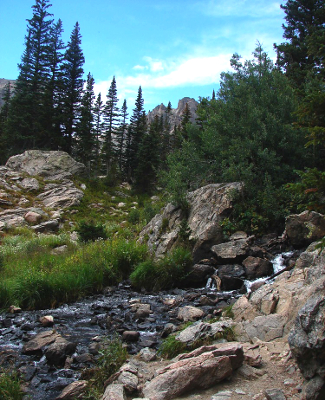
Photo above: Trail Ridge Road. Courtesy of the Library of Congress. Right: View of the ridges at Rocky Mountain National Park. Courtesy National Park Service.

Rocky Mountain National Park
Ask folks situated east of the Mississippi River to name some of the most iconic and visited national parks of the west and few will likely name Rocky Mountain National Park, but despite its relative anonymity in those eastern parts of the United States, it's far from unknown among those who love the huge national parks of the Rocky Mountains themselves.
Click here to Sponsor the page and how to reserve your ad.

Rocky Mountain National Park Then
For nearly one hundred years, since 1915, Rocky Mountain National Park has been set aside to allow visitors to view its natural wonders and scenic peaks. But there is history, not only in the land itself, but within the one hundred and fifty structures that dot the park, as well as Trail Ridge Road. The first section of Trail Ridge Road was completed in three years, from 1929 to 1932, and was 17.2 miles long, reaching from Deer Ridge to Fall River Pass. By 1938, it reached Grand Lake.
Photo above: Horseback ride in Rocky Mountain National Park, 1909-1932, National Photo Company Collection. Courtesy Library of Congress. Below: Ypsilon wind in the snow capped peaks. Courtesy National Park Service/Mariane Tucker.

Rocky Mountain National Park Now
Over four million people visit here every year, top twenty on the list of national parks, not far behind Yellowstone and ahead of Glacier, Grand Teton, and Zion. And there's no doubt to the reason why. It's huge, it's wonderful, it combines the two diverse sides of the Continental Divide into the wild wet west and the drier east. There's lakes and trails and history all wrapped up in a Colorado locale that's prime for visiting, no matter whether you love to camp or sightsee from your car after a motel stay. And boy, are there mountains. High, really high, mountains. Sixty over 12,000 feet high, with the tallest of them all, Long's Peak, at 14,259 feet. Yes, you'll be looking up alot, but there's also ground level fun as well, of the wet and dry variety. Grand Lake provides the backdrop on the western slopes for fishing, boating, and other activities.
There's a variety of visitor centers, five in all and one smaller information station, with three on the eastern side of the park, one on the western, and one in the interior, to visit, and guided tours to follow. There are trailheads for hikers all around the park, some available through the shuttle system. There's bighorn sheep, coyote, and elk in abundance, plus a whole lot more wildlife at every turn.
From the modern conveniences available just outside the park in the town of Estes Park to the various wilderness trails and peaks that dot the Rocky Mountain National Park itself, there's a wide variety of things to do in so many areas of the park, you'd have to spend the entire summer there just to hit the highlights. But whether you like to tour the scenery on foot, in a car, on a guided bus, or even a bike, you'll marvel at the scenery just outside that window. The guided walks and talks cover a wide variety of topics, of various lengths as well for the experienced hiker or novice Rocky Mountain visitor who likes a seat to listen to his guide. With over 265,000 acres, and those 60 mountains over 12,000 feet high, there's a whole lot to discuss and see.
T-Shirts and Souvenirs

Rocky Mountain National Park T-Shirts and Souvenirs.

Rocky Mountain National Park
Things You Should Not Miss
1. If you have the time and money, take the guided Trail Ridge Road Tour. It can be a bit pricey and lasts five hours, but this interpretive tour of the highest continuously paved road in the USA will take you to some of the best spots in the park. Starts at the Beaver Meadow Visitor Center and runs twice a week in the summer.
2. Take your time and drive through the park on your own, whether that be on the Trail Ridge Road, the Old Fall River Road, or others. This is a diverse park, where you'll see meadows and mountains, tundra and streams all along the way. These roads are not speedways, with posted limits of 15 MPH at certain places, and without guardrails at many spots. Take care and enjoy the beauty.
3. Let the rangers be your guide. Take one of the many free ranger guided walks or talks. There's a great variety on both sides of the park, from the four hour long Tundra to Trees walk at Alpine to the evening programs and campfire talks at the various Visitor Centers and campgrounds.
Photo above: Cub Lake in the morning. Courtesy National Park Service/Debra Miller.

Freeborn, the Novel about the Wild West's most unlikely hero.
Visitor FAQ
Rocky Mountain National Park Links
Rocky Mountain National Park
Estes Park Convention and Visitors Bureau
Granby, Colorado Lodging





